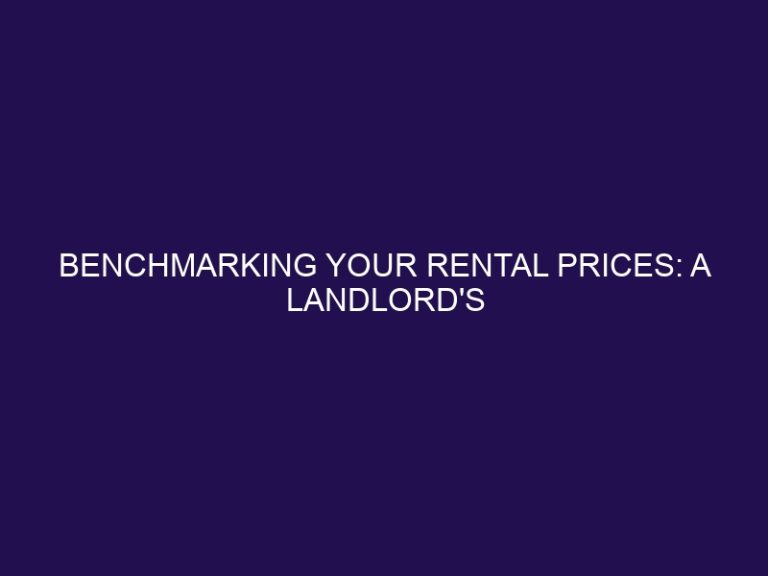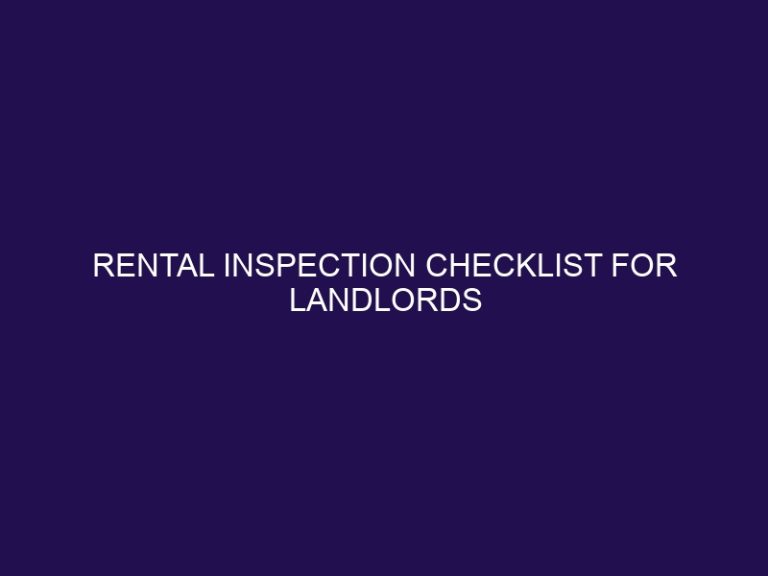Pricing Your Pet-Friendly Rental: What to Consider
A pet-friendly rental is a property that allows tenants to have pets, whether it be dogs, cats, or other small animals. As more people consider their pets to be part of the family, the demand for pet-friendly rentals has increased. Therefore, as a landlord or property owner, it is crucial to understand the importance and benefits of having a pet-friendly rental and how to price it accordingly.
Making your rental pet-friendly can attract more potential tenants, increase rental income, and help build a positive reputation as a landlord. According to a survey by Apartments.com, 75% of renters own pets, making it a significant market to tap into.
When pricing a pet-friendly rental, there are several factors to consider. These include:
- Location
- Type of pet-friendly amenities
- Size and layout of the rental
- Pet policies and fees
Prices may also vary depending on the type of pet, as larger animals may require a larger security deposit or additional fees.
To ensure that your pet-friendly rental is priced fairly, it is essential to research comparable rentals in your area and consider the demand for pet-friendly rentals. Consulting with a real estate professional can also provide valuable insights and advice.
Proper marketing is key to attracting potential tenants to your pet-friendly rental. Some tips for effective marketing include:
- Highlighting pet-friendly features in the listing
- Using pet-friendly keywords in online listings
- Utilizing social media and pet-friendly websites
- Offering special promotions for pet owners
In conclusion, pricing a pet-friendly rental requires careful consideration of various factors, including the demand in your area and the type of amenities and policies offered. By understanding the benefits of having a pet-friendly rental and effectively marketing it, you can attract potential tenants and potentially increase your rental income.
What is a Pet-Friendly Rental?
A pet-friendly rental is a type of housing that permits tenants to have pets under specific terms and conditions. These conditions may involve pet deposits, limitations based on breed or size, and guidelines for pet behavior and care. It is crucial to clarify and understand these policies before agreeing to a lease.
Why Should You Consider Making Your Rental Pet-Friendly?
As a landlord, you may be hesitant to allow pets in your rental property. However, there are many benefits to considering a pet-friendly rental. In this section, we will discuss the reasons why you should open your doors to furry tenants. From attracting a larger pool of potential tenants to increasing your rental income and building a positive reputation, there are compelling reasons to make your rental pet-friendly. So, let’s delve into each of these benefits and see how they can positively impact your rental business.
1. Attract More Potential Tenants
- Attract more potential tenants by ensuring your rental is pet-friendly and allowing pets, as well as promoting pet-friendly amenities.
- Advertise the pet-friendly aspects of your rental in listings and on social media to attract pet owners.
- Offer incentives such as pet play areas or pet grooming services to further attract potential tenants.
2. Increase Rental Income
- Improve Property: Enhance amenities and services to justify higher rent.
- Market Analysis: Assess local pet-friendly rental demand and pricing trends to increase rental income.
- Pet Fees: Implement reasonable pet fees to boost rental income and attract pet owners.
True story: By allowing pets and charging a small pet fee, a landlord in a pet-loving community increased rental income by 15%.
3. Build a Positive Reputation
- Maintain Clean and Well-Kept Property
- Address Tenant Concerns Promptly
- Establish Clear and Fair Pet Policies
- Promote Community Engagement and Pet-Friendly Events
Building a positive reputation for your pet-friendly rental involves proactive maintenance, transparent communication, and fostering a welcoming community for tenants and their pets.
What Factors Should You Consider When Pricing a Pet-Friendly Rental?
When it comes to renting out a property, pricing can be a tricky task. And when you factor in the additional considerations that come with pet-friendly rentals, it can become even more challenging. In this section, we will discuss the key factors that should be taken into account when determining the price for your pet-friendly rental. From the location and type of pet-friendly amenities to the size and layout of the rental, as well as the pet policies and associated fees, we’ll cover everything you need to consider to effectively price your pet-friendly rental.
1. Location
- Research the neighborhood’s pet-friendliness and location.
- Evaluate proximity to pet-friendly parks and facilities in the area.
- Consider the availability of pet services and amenities in the location.
I once sought a pet-friendly rental, and assessing the location was crucial for my furry friend’s well-being.
2. Type of Pet-Friendly Amenities
- Outdoor amenities: Provide dedicated dog parks, walking trails, and pet relief areas.
- Indoor facilities: Include pet washing stations, pet spas, and play areas.
- Pet services: Offer grooming, training, and pet-sitting services on-site.
Pro-tip: Create a pet-friendly community by organizing pet events and meet-ups for socialization.
3. Size and Layout of Rental
- Consider the square footage and room configuration of the rental.
- Evaluate if the layout is suitable for pets and their comfort.
- Assess the outdoor space for pet activities and exercise.
Pro-tip: Create a designated pet area within the rental to promote a pet-friendly environment.
4. Pet Policies and Fees
- Clearly establish pet policies regarding the types of pets allowed, their size, and the number allowed per unit.
- Set reasonable pet fees for additional cleaning, pet amenities, or pet damage protection.
- Outline rules for pet behavior, waste disposal, and noise control to ensure a harmonious living environment for all tenants.
- Transparently communicate these policies to potential tenants to attract responsible pet owners and boost tenant satisfaction, ultimately reducing vacancy rates.
A property owner successfully implemented pet-friendly policies, resulting in a positive impact on tenant satisfaction and vacancy rates.
How Can You Ensure Your Pet-Friendly Rental is Priced Fairly?
As a landlord with a pet-friendly rental, determining the right price for your property can be a challenging task. You want to ensure that you are not only making a profit, but also attracting responsible and reliable tenants who have furry companions. In this section, we will discuss three key factors to consider when setting the price for your pet-friendly rental. By researching comparable rentals, assessing the demand for pet-friendly properties in your area, and seeking guidance from a real estate professional, you can ensure that your rental is priced fairly for both you and your potential tenants.
1. Research Comparable Rentals
- Conduct research on comparable rental properties in your area.
- Analyze their rental rates, amenities, and pet policies.
- Take into account the size, location, and condition of these rentals.
- Adjust your pet-friendly rental price accordingly.
Pro-tip: Emphasize any unique pet-friendly features to make your rental stand out in the market.
2. Consider the Demand for Pet-Friendly Rentals in Your Area
Assess the demand for pet-friendly rentals in your area by examining rental listings, speaking with local property managers, and researching occupancy rates for such properties. Consider factors influencing demand such as pet ownership statistics, proximity to pet-friendly amenities, and the availability of pet-friendly rental properties.
3. Consult with a Real Estate Professional
- Research similar pet-friendly rental properties in the vicinity.
- Seek guidance on establishing competitive pet policies and fees.
- Discuss the demand for pet-friendly rentals and the potential rental income.
Pro-tip: Collaborate with a real estate professional who has experience with pet-friendly rentals for valuable insights.
What Are Some Tips for Marketing Your Pet-Friendly Rental?
As a landlord with a pet-friendly rental property, it’s important to effectively market your space to potential tenants who have furry companions. In this section, we will discuss key tips for marketing your pet-friendly rental. By highlighting pet-friendly features in your listing, using specific keywords, utilizing social media and pet-friendly websites, and offering special promotions, you can attract the right tenants and showcase the unique benefits of your rental for pet owners.
1. Highlight Pet-Friendly Features in Listing
- Include detailed descriptions of pet-friendly amenities such as fenced yards and pet washing stations in your listing.
- Emphasize nearby pet-friendly attractions, such as parks and pet stores, to attract pet-owning tenants.
- Showcase pet-friendly policies, such as no weight restrictions or breed limitations, to foster a vibrant, pet-loving community.
A property owner successfully highlighted their rental’s pet-friendly features in their listing, resulting in numerous pet-owning tenants and a thriving, pet-friendly community.
2. Use Pet-Friendly Keywords in Online Listings
- Conduct research on popular pet-related search terms and phrases.
- Incorporate keywords like ‘pet-friendly,’ ‘pet-friendly apartment,’ ‘pets allowed,’ ‘dog-friendly,’ etc. in property descriptions, headings, and photo captions.
- Utilize online tools for keyword analysis and optimization.
- By utilizing pet-friendly keywords in their rental listing, a friend was able to attract numerous interested tenants and ultimately secure responsible pet owners as tenants.
Recently, a friend used pet-friendly keywords in their rental listing and attracted numerous interested tenants, ultimately securing responsible pet owners as tenants.
3. Utilize Social Media and Pet-Friendly Websites
- Create compelling social media posts highlighting the pet-friendly amenities.
- Share pet-related content on popular platforms such as Instagram, Facebook, and Twitter.
- Partner with pet-friendly websites for promotional listings and featured content.
4. Offer Special Promotions for Pet Owners
- Provide discounted or waived pet fees for new tenants with pets.
- Include welcome packages with pet treats and toys for new pet-owning tenants.
- Plan and host pet-friendly community events to cultivate a sense of belonging for pet owners.
- Collaborate with local pet businesses to offer exclusive discounts and promotions for your tenants.
By offering special promotions for pet owners, you can create a welcoming environment that promotes tenant loyalty and satisfaction.
Frequently Asked Questions
Q1: What factors should I consider when determining the cost of a pet deposit for my pet-friendly rental property?
A1: When determining the cost of a pet deposit for your pet-friendly rental property, you should consider the type and size of the pet, the value of the property, and your location. Other factors such as breed restrictions, weight limits, and additional rent may also play a role in determining the cost.
Q2: Are separate pet deposits legal in all states?
A2: No, separate pet deposits are only legal in some states. It is important for landlords to check their state’s laws regarding pet deposits and ensure they are following them.
Q3: What are the benefits of charging a pet deposit for my rental property?
A3: Charging a pet deposit is beneficial because pets can cause damage to the property, and the deposit serves as a form of advance compensation for any potential damage.
Q4: Can I charge both a pet deposit and a security deposit in North Dakota?
A4: Yes, landlords in North Dakota can legally charge both a pet deposit and a security deposit for their rental properties.
Q5: How much should I charge for pet rent?
A5: The amount of pet rent you charge will vary depending on your location and the size and type of pet. It is important to research the market and consider the potential expenses and damages that may arise from having a pet in the rental space.
Q6: What are the typical expenses associated with owning a pet?
A6: The expenses of owning a pet include a pet deposit, monthly pet rent, food, water, toys, grooming expenses, and potential damage to the rental property. It is important to budget and consider these expenses before adopting a pet as they can add up quickly.







